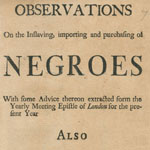 |
Anthony Benezet, Observations on the Inslaving, Importing and Purchasing of Negroes (Philadelphia, 1759).
For most Quakers antislavery was an inward-looking movement, concerned with purifying their own ranks rather than changing society. Benezet helped make many of them antislavery activists. He was a hands-on abolitionist, active in learning about the local black community, and, in this same year, beginning his school for Philadelphia blacks. His many pamphlets were reprinted in Great Britain and helped fuel the movement there against the slave trade. This is the first of his many antislavery works and includes, in addition to a moral appeal, documentary accounts of the horrors of slave trading drawn from the writings of slave traders and African travelers. He was a Library Company member, and the works he consulted were available to him in our collection. |
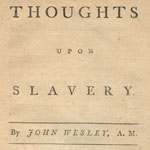 |
John Wesley, Thoughts Upon Slavery (London, printed; Reprinted in Philadelphia, 1774).
“Liberty is the right of every human creature, as soon as he breathes the vital air. And no human law can deprive him of that right, which he derives from the law of nature.”
Wesley’s impassioned pamphlet emphasized how slavery debased and dehumanized both the enslaved and the enslaver His antislavery convictions infused early Methodism and made it the most decidedly antislavery denomination in the era of the Revolution and the Early Republic. Methodism’s emphasis on individual spiritual value and forging an egalitarian Christian community made it attractive to many blacks, who saw in it a role for themselves. “Nature created man free; and grace invites him to assert his freedom.” |
![[Benjamin Rush,] An Address to the Inhabitants of the British Settlements in America, Upon Slave-Keeping (Philadelphia, 1773).](images/section2/th4-6.jpg)
|
[Benjamin Rush,] An Address to the Inhabitants of the British Settlements in America, Upon Slave-Keeping (Philadelphia, 1773).
The young revolutionary Benjamin Rush wrote this pamphlet to support legislation doubling the tax on importing slaves, making further importation prohibitively expensive. His refutation of proslavery arguments and defense of the character of African people was successful and the new law was a further blow to slavery in Pennsylvania.
Why publish this anonymously? Perhaps Rush was embarrassed that he and his family were slaveholders. He was in fact timid about black freedom, thinking only the young should be free and educated and the already-enslaved, “ having all the low vices of slavery,” should be kept in bondage. He would later, however, become one of the most supportive and valuable allies of slaves and free blacks. This copy is printer John Dunlap’s shop copy, marked up for a second edition. He notes that 1,200 copies of the first edition were all sold, and that Anthony Benezet purchased 500 copies of the second edition. Dunlap gave this copy to Rush in 1811. |
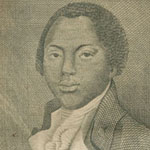 |
Olaudah Equiano, The Interesting Narrative of the Life of Olaudah Equiano, or Gustavus Vassa, the African, Written by Himself. First American edition (New York, 1791).
Equiano’s narrative, first published in London in 1789, was an instant best-seller, the unvarnished and unmitigated autobiography of an enslaved African, recounting his capture and the horror of the middle passage first hand, and his life in bondage and as a British seaman. It’s a rousing adventure covering the entire Atlantic world from Africa to the West Indies, to North America and the Arctic region. Settled in London, he was an active participant in the campaign against the slave trade and his book a central text for the movement. In his lifetime he shepherded it through nine editions, and it continued in print long after his death.
But recently discovered evidence, still inconclusive, suggests he was not African born, but rather a South Carolina slave. If so, his position is even more unique as the first African American to assume and create an African persona. Whatever the case, the declaration on the title page, “Written by Himself,” stands unchallenged. |
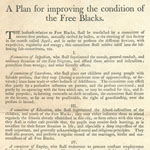 |
Pennsylvania Society for Promoting the Abolition of Slavery, A Plan for Improving the Condition of Free Blacks, An Address to the Public (Philadelphia, 1789).
The world’s first antislavery society was founded here in 1775. Inactive during the Revolution, it was reorganized in the years after. The Society became a major force in local black affairs, establishing schools, arranging indentures for freed slaves, providing legal defense for blacks, defending fugitive slaves, and constantly petitioning for abolition and black rights. It was also all white and paternalistic, with only two black members prior to the Civil War, and no women.
In this action plan signed by Benjamin Franklin, the Society established itself as a de facto Ministry of Black Affairs, with committees on education and employment, to “superintend the morals, general conduct and ordinary situations of the Free Negroes.” Like other early abolitionists of this time, they were circumspect regarding the emancipation of those who “having been treated as a brute animal, too frequently sinks below the common standard of the human species. . . . Under such circumstances, freedom may often prove a misfortune to himself, and prejudicial to society.” |
In the late 18th century blacks increasingly entered the print world with their own voices. The African-born slave poet Phillis Wheatley had been in print for several years in newspapers and broadsides before her first book was published in 1773. She was the unofficial poet laureate of her Boston neighborhood, most of her verse commemorating people and events of the region.
Benjamin Banneker, born free near Baltimore, had a gift for mathematics and came to the attention of surveyor Andrew Ellicott, who hired him to help survey the site of the District of Columbia. Banneker’s almanacs were published in eighteen editions between 1791 and 1796. In later antislavery literature challenging the inferiority of African Americans, Wheatley and Banneker were the most frequently cited examples of the equal intelligence, talent, and ability of black people.
|
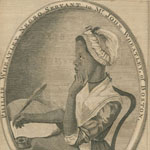 |
Phillis Wheatley, Poems on Various Subjects, Religious and Moral (London, 1773). |
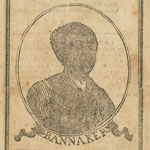 |
Benjamin Banneker, Banneker’s New Jersey, Pennsylvania, Delaware, Maryland and Virginia Almanac, or Ephemeris, for the Year of Our Lord 1795 (Baltimore, 1794). |


![[Benjamin Rush,] An Address to the Inhabitants of the British Settlements in America, Upon Slave-Keeping (Philadelphia, 1773).](images/section2/th4-6.jpg)



